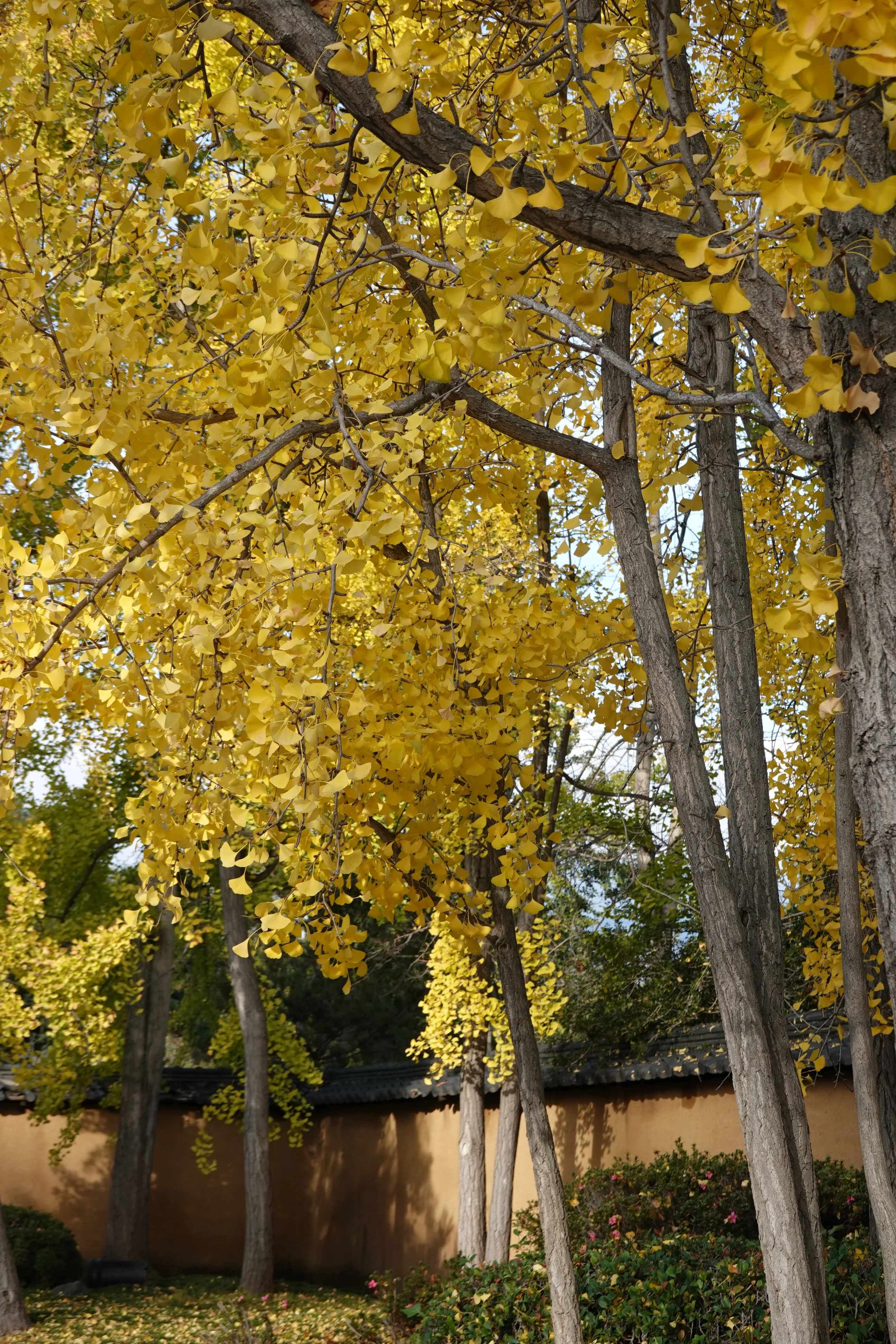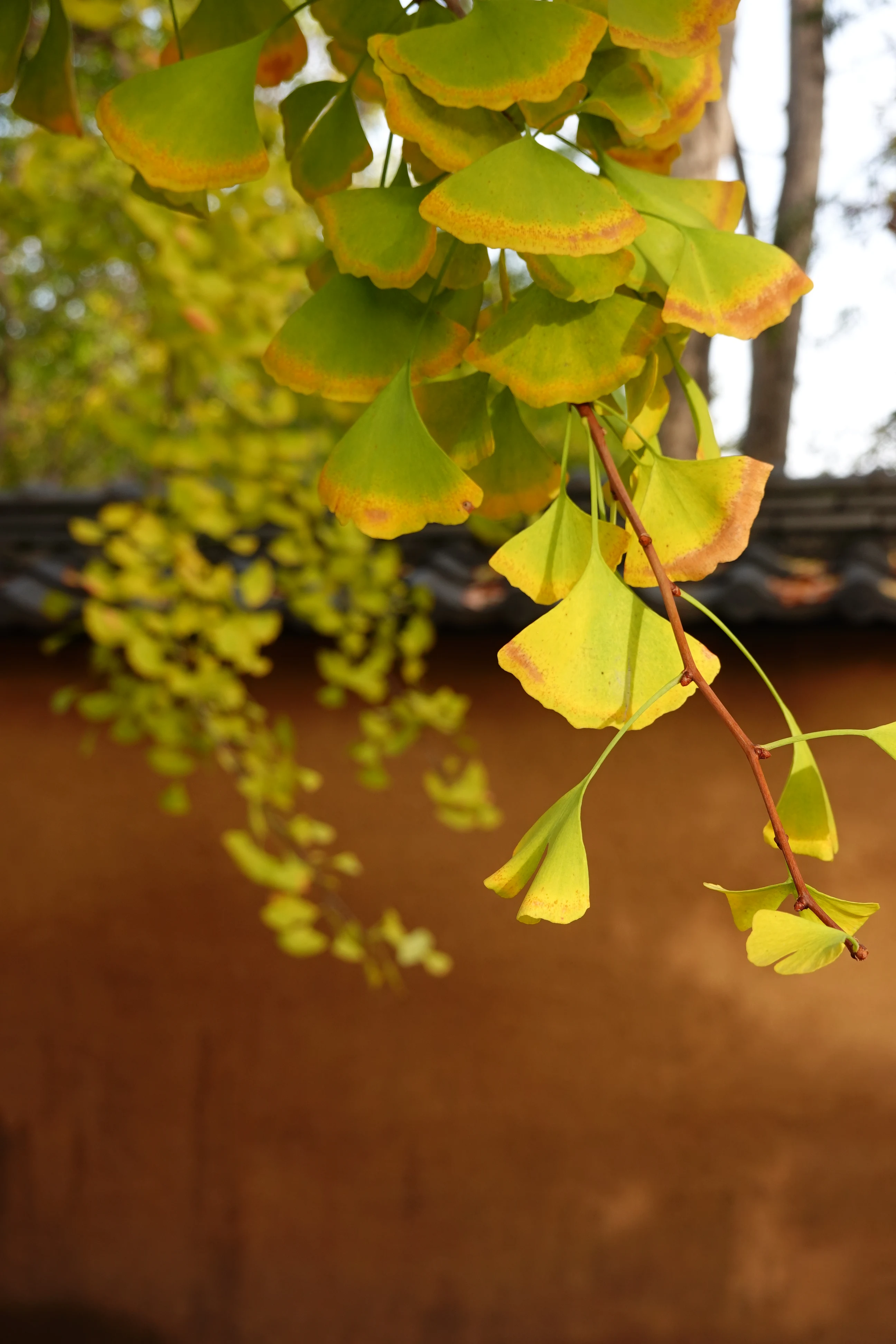"During autumn, the leaves turn a bright yellow, then fall, sometimes within a short space of time (one to 15 days)." That's a true statement about Ginkgo. From 2020.11.17 to 2020.12.15, in just one month, the ginkgo trees in the Los Angeles Arboretum have completely changed from green leaves to yellow leaves. The green-leaved ginkgo trees seem to be less special and not so conspicuous. When you walk past them, you often just glance at them casually. Once the color changes, the whole scene changes dramatically. The yellow-leaf ginkgo trees bring some melancholy, but sometimes in the sun, the glittering leaves bring jumping joy to me. Sometimes I saw a few little children playing with fallen leaves, which made me envious of their innocence in enjoying life and nature. Ginkgo biloba, commonly known as ginkgo or gingko, also known as the maidenhair tree due to its beautiful fan shaped leaves that resemble a maidenhair fern frond. Some fossils datied back 200 million years. The leaves are unique among seed plants, being fan-shaped with veins radiating out into the leaf blade. Ginkgos are dioecious (separate male and female trees). Nurseries typically sell only male trees because female trees produce seeds encased in fleshy, fruit-like cone which, at maturity in autumn, are messy and emit a noxious, foul odor upon falling to the ground and splitting open. Chinese scientists published a draft genome of Ginkgo biloba in 2016. The tree has a large genome of 10.6 billion DNA nucleobase “letters” (the human genome has three billion) and about 41,840 predicted genes which enable a considerable number of antibacterial and chemical defense mechanisms. The nut-like gametophytes inside the seeds are particularly esteemed in Asia. In Chinese culture, they are believed to have health benefits; some also consider them to have aphrodisiac qualities. The first use as a medicine is recorded in the late 15th century in China; among western countries, its first registered medicinal use was in Germany in 1965. It has been used in traditional treatment of Alzheimer’s disease. Clinical trials support the extract’s modest efficacy for the indicated conditions. Studies have demonstrated mixed results for preventing or slowing the onset of Alzheimer’s disease. Although extracts of Ginkgo biloba leaf sold as dietary supplements may be marketed as being beneficial for cognitive function, there is no evidence for effects on memory or attention in healthy people. Ginkgos are popular subjects for growing as penjing and bonsai. The ginkgo leaf is the symbol of the Urasenke school of Japanese tea ceremony. The tree is the official tree of the Japanese capital of Tokyo, and the symbol of Tokyo is a ginkgo leaf. Ginkgo has also become the city tree of Chengdu, Dandong, Huzhou and Linyi in China. Ginkgo is often planted in temples in central subtropical, northern subtropical, mid-temperate and plateau temperate regions, as an alternative tree species for Ficus religiosa, to express the meaning of Buddhist enlightenment, but also because of its unique fruit and leaf shape, tall tree shape and long-lasting Life span, becoming the sacred tree of Chinese Buddhism.
「在秋天,有時在很短的時間內(1到15天),葉子變成鮮黃色,然後掉落。」真是一點都不錯對銀杏的描述。從 2020.11.17 至 2020.12.15,短短一個月裏,洛杉磯植物園裏的銀杏樹,完全改頭換面,已從綠葉完全變成黃葉。綠葉的銀杏樹似乎比較不那麼特別,不是那麼顯眼,走過它們時,常常只是不經意的輕瞄兩眼。一但搖身變色,整個場景也戲劇性的轉變,黃葉的銀杏樹帶來些愁悵,但有時在陽光下,晶晶亮亮閃爍的葉子,卻帶來些跳躍的喜悅。偶爾會看到幾個小娃兒,撥玩著落葉,讓人不禁羨慕他們享受生命、享受自然的童真。銀杏,也被稱為白果樹 (它又名公孫樹、鴨掌樹、鴨腳樹、鴨腳子等) 由於其美麗的扇形葉子類似於鐵線蕨的葉子。它的化石可以追溯到2億年前。它的葉片在種子植物中是獨特的,呈扇形,葉片的葉脈放射狀。銀杏是雌雄異株(雌雄樹分開)。苗圃通常只出售雄樹,因為雌樹產生的種子包裹在肉質、水果狀的球果中,這些球果在秋天成熟時,種子很髒,掉落在地上並裂開時會散發出有毒的惡臭。中國科學家在2016年發布了銀杏基因組草案。銀杏有 106 億個 DNA 核鹼基“字母”(人類基因組有30億個)的大基因組,以及約 41,840 個預測基因,這些基因可產生多種抗菌和化學防禦機制。種子內部的堅果狀配子體在亞洲尤其受到重視。在中國文化中,它們被認為對健康有益處。有些人還認為它們有壯陽的成份。15世紀末,中國最先記錄了這種藥物的使用。在西方國家中,它於1965年在德國首次註冊用於醫學用途。它已被用於治療阿爾茨海默氏病。臨床試驗證明它在指定條件下的適度功效。研究表明,對於預防或減緩阿爾茨海默氏病的發作,結果不一。儘管作為膳食補充劑的銀杏葉提取物可能對認知功能有益,但沒有證據證明對健康人的記憶或注意力有影響。銀杏很常用來作盆栽。銀杏葉是裏千家日本茶道學校的象徵。它也是日本首都東京的官方樹,東京的標誌是銀杏葉。銀杏亦成為中國成都市、丹東市、湖州市及臨沂市的市樹。在中亞熱帶、北亞熱帶、中溫帶和高原溫帶地區的寺廟中常種植銀杏,作為菩提樹的替代樹種,以表達佛教的覺悟之意,更因其獨特的果實和葉片形態、高大的樹形及長久的壽命,成為漢傳佛教的聖樹。
The photos below are Ginkgo biloba 'Cleveland' syn. CLEVELANDS GOLDEN GLOBE® (Knowen in China as ‘Jin Qiu’). It is a very good male cultivar. It was discovered by David Cleveland in 1990 as a chance seedling in Fort Valley, Georgia, in the U.S.A.
下面的照片是,「克利夫蘭」銀杏,又稱 CLEVELANDS GOLDEN GLOBE®(在中國稱為「金秋」)是一個非常好的雄性品種。1990 年大衛·克利夫蘭 (David Cleveland) 在美國喬治亞州福特谷 (Fort Valley) 發現它的機遇實生苗。















The photos below are Ginkgo biloba 'Saratoga'. The Saratoga Ginkgo is a medium-sized, deciduous, fruitless maidenhair tree. This cultivar originated as a seedling selected in 1975 by the Saratoga Horticultural Foundation, Inc. in San Martin, California. It has unusually large, pendulous fan-shaped leaves which have very attractive yellowy-green color through the summer and then turn into a spectacular rich golden in autumn.
下面的照片是,「薩拉託加」銀杏。 薩拉託加銀杏是一種中等大小的落葉無結果的銀杏樹。這品種起源於加州聖馬丁的薩拉託加園藝基金會於 1975 年選擇的幼苗。 它有異常大、下垂的扇形葉子,在夏天呈現出非常迷人的黃綠色,然後在秋天變成壯觀的濃郁金色。








The photos below are Ginkgo biloba 'Autumn Gold'. 'Autumn Gold' is an all-male cultivar typically growing at maturity to 40-50' with a symmetrical, broadly spreading habit. Leaves turn a uniform golden yellow in autumn and persist for several weeks. When the leaves do drop, they drop rapidly, forming a golden carpet around the tree.
下面的照片是,「秋金」銀杏。 「秋金」是一種全雄性品種,成熟時通常生長到 40-50 英寸,具有對稱、廣泛傳播的習性。 秋天葉子變成均勻的金黃色,並持續數週。當樹葉掉落時,它們會迅速掉落,在樹周圍形成金色的地毯。




The photos below are ginkgos that I do not know their species at the Los Angeles Arboretum.
下面的照片是在洛杉磯植物園我不知道它們品種的銀杏。






The ginkgo trees at the Huntington Library are also very beautiful.
亨廷頓圖書館的銀杏樹也非常漂亮。


















In May of 2020 walking around the streets nearby, I discovered a row of ginkgo trees. I also discovered the ginkgo ovules.
2020年5月,我在附近的街道上行走時,發現了一排銀杏樹。 我還發現了銀杏胚珠。



Notes 筆記
- Ginkgo biloba, commonly known as ginkgo or gingko, also known as the maidenhair tree, is the only living species in the division Ginkgophyta, all others being extinct. It is a member of a very old genus, with some fossils dating back 200 million years.
- The genus name Ginkgo is regarded as a misspelling of the Japanese gin kyo, “silver apricot”, which is derived from the Chinese 銀杏 used in Chinese herbalism literature.
- Ginkgos are large trees, normally reaching a height of 20–35 m (66–115 ft), with some specimens in China being over 50 m (160 ft).
- During autumn, the leaves turn a bright yellow, then fall, sometimes within a short space of time (one to 15 days).
- A combination of resistance to disease, insect-resistant wood and the ability to form aerial roots and sprouts makes ginkgos long-lived, with some specimens claimed to be more than 2,500 years old.
- The leaves are unique among seed plants, being fan-shaped with veins radiating out into the leaf blade, sometimes bifurcating (splitting), but never anastomosing to form a network.
- Ginkgos are dioecious, with separate sexes, some trees being female and others being male.
- Chinese scientists published a draft genome of Ginkgo biloba in 2016. The tree has a large genome of 10.6 billion DNA nucleobase “letters” (the human genome has three billion) and about 41,840 predicted genes which enable a considerable number of antibacterial and chemical defense mechanisms.
- Although Ginkgo biloba and other species of the genus were once widespread throughout the world, its range shrank. For centuries, it was thought to be extinct in the wild, but is now known to grow in at least two small areas in Zhejiang province in eastern China, in the Tianmushan Reserve.
- In many areas of China, it has been long cultivated, and it is common in the southern third of the country. It has also been commonly cultivated in North America for over 200 years and in Europe for close to 300, but during that time, it has never become significantly naturalized.
- Ginkgos are popular subjects for growing as penjing and bonsai; they can be kept artificially small and tended over centuries. The trees are easy to propagate from seed.
- The nut-like gametophytes inside the seeds are particularly esteemed in Asia, and are a traditional Chinese food. Ginkgo nuts are used in congee, and are often served at special occasions such as weddings and the Chinese New Year (as part of the vegetarian dish called Buddha’s delight). In Chinese culture, they are believed to have health benefits; some also consider them to have aphrodisiac qualities.
- Japanese cooks add ginkgo seeds (called ginnan) to dishes such as chawanmushi, and cooked seeds are often eaten along with other dishes.
- When eaten in large quantities or over a long period, the gametophyte (meat) of the seed can cause poisoning by 4′-O-methylpyridoxine (MPN). Studies have demonstrated the convulsions caused by MPN can be prevented or treated successfully with pyridoxine (vitamin B6).
- Some people are sensitive to the chemicals in the sarcotesta, the outer fleshy coating. These people should handle the seeds with care.
- The first use as a medicine is recorded in the late 15th century in China; among western countries, its first registered medicinal use was in Germany in 1965. It has been used in traditional treatment of Alzheimer’s disease. Clinical trials support the extract’s modest efficacy for the indicated conditions. Studies have demonstrated mixed results for preventing or slowing the onset of Alzheimer’s disease.
- Although extracts of Ginkgo biloba leaf sold as dietary supplements may be marketed as being beneficial for cognitive function, there is no evidence for effects on memory or attention in healthy people.
- The use of Ginkgo biloba leaf extracts may have undesirable effects, especially for individuals with blood circulation disorders and those taking anticoagulants.
- The ginkgo is a living fossil, with fossils recognizably related to modern ginkgo from the Permian, dating back 270 million years.
- The ginkgo leaf is the symbol of the Urasenke school of Japanese tea ceremony. The tree is the official tree of the Japanese capital of Tokyo, and the symbol of Tokyo is a ginkgo leaf. Ginkgo has also become the city tree of Chengdu, Dandong, Huzhou and Linyi in China.
- Extreme examples of the ginkgo’s tenacity may be seen in Hiroshima, Japan, where six trees growing between 1–2 kilometers (0.62–1.24 mi) from the 1945 atom bomb explosion were among the few living things in the area to survive the blast. Although almost all other plants (and animals) in the area were killed.
- Ginkgo is often planted in temples in central subtropical, northern subtropical, mid-temperate and plateau temperate regions, as an alternative tree species for Ficus religiosa, to express the meaning of Buddhist enlightenment, but also because of its unique fruit and leaf shape, tall tree shape and long-lasting Life span, becoming the sacred tree of Chinese Buddhism.
- 銀杏,也被稱為白果樹 (註:中文的維基百科記載,它又名公孫樹、鴨掌樹、鴨腳樹、鴨腳子等),是銀杏科中唯一存活的物種,所有其他物種都已滅絕。它是一個非常古老的種類,它的化石可以追溯到2億年前。
- 銀杏屬的名稱被認為是日本杜松子酒“銀杏”的拼寫錯誤。它源於中國草藥學文獻的銀杏。
- 銀杏是大樹,通常會達到 20-35 公尺(66-115 英呎)的高度,有些中國的銀杏超過 50 公尺(160英呎)高。
- 在秋天,有時在很短的時間內(1到15天),葉子變成鮮黃色,然後掉落。
- 由於抗病性,抗蟲的木材以及有能力結合形成的氣生根和新芽,使銀杏壽命長,有些標本據稱已有2500多年的歷史。
- 它的葉片在種子植物中是獨特的,呈扇形,葉片的葉脈放射狀,有時分叉(裂開),但從未吻合形成網絡。
- 銀杏是雌雄異株,有不同的性別,有些樹是雌性,另一些是雄性。
- 中國科學家在2016年發布了銀杏基因組草案。銀杏有106億個DNA核鹼基“字母”(人類基因組有30億個)的大基因組,以及約41,840個預測基因,這些基因可產生多種抗菌和化學防禦機制。
- 雖然銀杏和該屬的其他物種曾經在世界各地廣泛分佈,但其範圍縮小了。幾個世紀以來,人們一直認為它在野外已經滅絕,但現在知道它在中國東部浙江省天目山保護區的兩個小地區生長。
- 在中國的許多地區尤其是中國南部,已長期種它。在北美種植已有近200年的歷史,在歐洲也有近300年的歷史。但是在那段時間裡,它從未適應當地的生長環境。
- 銀杏很常用來作盆栽。甚至經過幾個世紀的養育,它們都可以保持小巧。它們很容易從種子開始繁殖。
- 種子內部的堅果狀配子體在亞洲尤其受到重視,是中國傳統食品。銀杏堅果用於粥中,常在婚禮和農曆新年等特殊場合使用(作為素食菜的一部分,稱為羅漢齋)。 在中國文化中,它們被認為對健康有益處。有些人還認為它們有壯陽的成份。
- 日本廚師在茶碗蒸等菜餚中添加銀杏子(稱為ginnan),煮熟的種子常與其他菜餚一起食用。
- 當大量或長期食用時,種子的配子體(肉)可能會因 MPN 而中毒。研究發現,維生素 B6 可以成功預防或治療 MPN 引起的抽搐。
- 某些人對外部肉質塗層中的化學物質會敏感,這些人在處理種子時要小心。
- 15世紀末,中國首次記錄了這種藥物的使用。在西方國家中,它於1965年在德國首次註冊用於醫學用途。它已被用於治療阿爾茨海默氏病。臨床試驗證明它在指定條件下的適度功效。研究表明,對於預防或減緩阿爾茨海默氏病的發作,結果不一。
- 儘管作為膳食補充劑的銀杏葉提取物可能對認知功能有益,但沒有證據證明對健康人的記憶或注意力有影響。
- 使用銀杏葉提取物可能會產生不良影響,特別是對於血液循環異常的人和服用抗凝劑的人。
- 銀杏是一種活化石,其化石與二疊紀的現代銀杏有關,可追溯到2.7億年前。
- 銀杏葉是裏千家日本茶道學校的象徵。它也是日本首都東京的官方樹,東京的標誌是銀杏葉。銀杏亦成為中國成都市、丹東市、湖州市及臨沂市的市樹。
- 在日本廣島,可以看到銀杏堅韌性的例子,從1945年原子彈爆炸起,生長在1-2公里(0.62-1.24英里)之間的六棵樹是該地區倖免於難的生物。 雖然這地區幾乎所有其他植物(和動物)都被殺死。
- 在中亞熱帶、北亞熱帶、中溫帶和高原溫帶地區的寺廟中常種植銀杏,作為菩提樹的替代樹種,以表達佛教的覺悟之意,更因其獨特的果實和葉片形態、高大的樹形及長久的壽命,成為漢傳佛教的聖樹。
References 參考資料
- Wikipedia: Ginkgo biloba
- 維基百科: 銀杏
- NPC Ginkgo: Ginkgo biloba ‘Cleveland’ syn. CLEVELANDS GOLDEN GLOBE®
- Chicago Botanic Garden: Saratoga Ginkgo
- Missouri Botanical Garden: Ginkgo biloba 'Autumn Gold'
Plants Posts 植物的帖子
Comments